




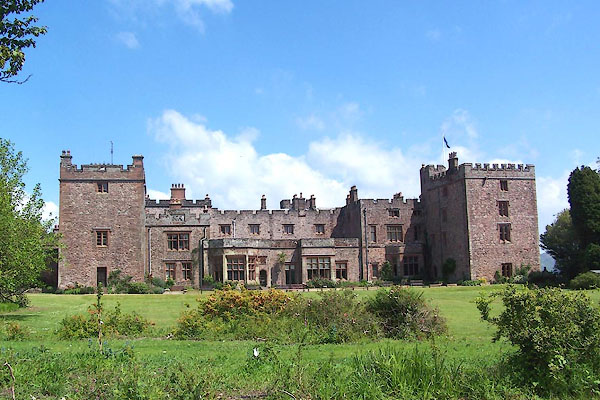
BNT92.jpg (taken 5.6.2007)

BTO16.jpg (taken 24.9.2010)
placename:- Muncaster Castle
placename:- Momaster
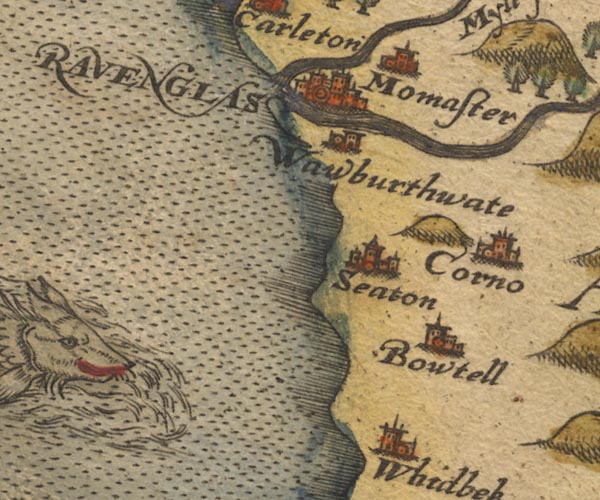
Sax9SD09.jpg
Church, symbol for a parish or village, with a parish church. "Momaster"
item:- private collection : 2
Image © see bottom of page
placename:- Momaster

SP11SD19.jpg
"Momaster"
circle, building, tower
item:- private collection : 16
Image © see bottom of page
placename:- Momaster
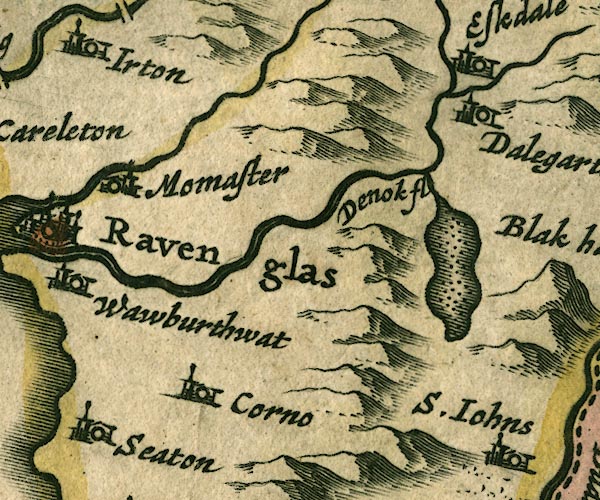
JAN3SD19.jpg
"Momaster"
Buildings and tower.
item:- JandMN : 88
Image © see bottom of page
placename:- Moncaster
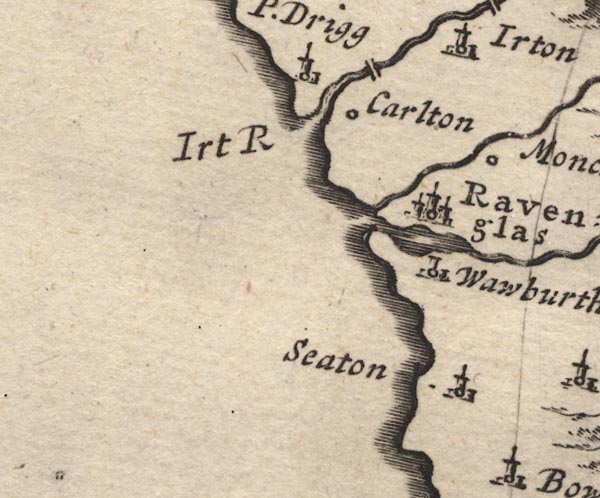
MD12SD09.jpg
"Moncaster"
Circle.
item:- JandMN : 90
Image © see bottom of page
placename:- Moncaster
 goto source
goto source"... Moncaster, near Whitehaven, the Seat of Sir Joseph Pennington, one of the Knights of the Shire in the present Parliament. ..."
placename:- Moncaster Hall
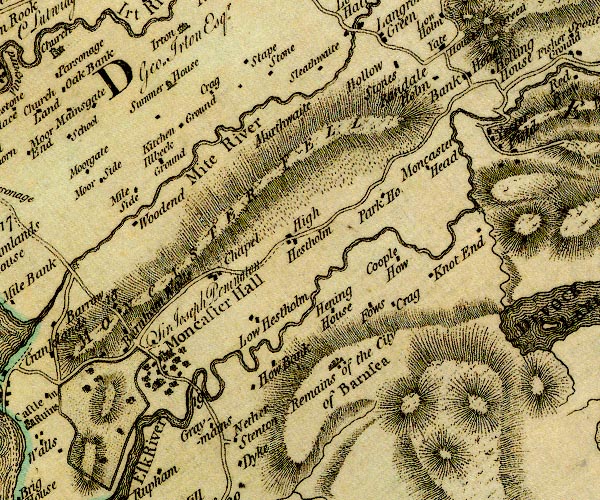
D4SD19NW.jpg
"Moncaster Hall / Sir Joseph Penington"
house, and park, also the church
item:- Carlisle Library : Map 2
Image © Carlisle Library
placename:- Moncaster house

Ws02SD09.jpg
item:- Armitt Library : A1221.1
Image © see bottom of page
placename:- Muncaster Castle
item:- Luck of Muncaster
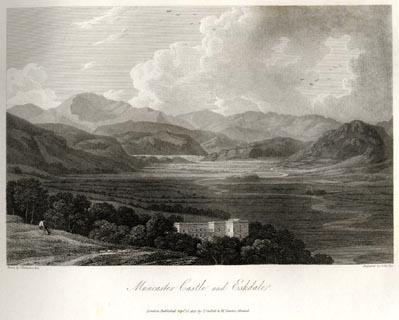 click to enlarge
click to enlargeFA0408.jpg
printed, bottom left, right, centre "Drawn by J. Farington R.A. / Engraved by John Pye. / Muncaster Castle and Eskdale. / London Published Septr. 15, 1815, by T. Cadell &W. Davies, Strand."
Descriptive text:- "VIEW OF MUNCASTER CASTLE."
"THE Manor of Muncaster is known to have belonged to the Pennington family as early as the reign of Henry II. Sir John Pennington in the reign of Henry VI. is said to have secreted that unhappy monarch in his flight from his enemies; and the tradition of the family is, that on quitting Muncaster he presented his host with a small glass vessel, still preserved in the family, and called the Luck of Muncaster, to the preservation of which a considerable degree of superstition has attached. This Sir John Pennington is said to have been a distinguished military character, and to have commanded the left wing of the English army in an expedition against Scotland. His grandson, of the same name, was in the battle of Flodden Field. Another descendant, of the same name, was Admiral to King Charles I. and much trusted by that monarch in naval affairs. Sir William Pennington, grandson of the last-mentioned Sir John, was created a Baronet in 1676. Sir John Pennington, the fifth Baronet, was, in 1783, created Lord Muncaster, of the kingdom of Ireland; he died in 1813, leaving only one surviving daughter, married to Lord Lindsay, son of the Earl of Balcarras, when the title of Muncaster and the Muncaster estates, being settled on male heirs, devolved to his brother, General Lowther Pennington, now Lord Muncaster."
"Muncaster Castle, which retains the principal tower of the ancient fortified mansion, though it has lost its original form, was nearly rebuilt by the late Lord Muncaster. It stands on an eminence, nearly surrounded by beautiful plantations, and commanding in front a fine view of the Vale of Esk, flanked on each side, and terminated in front, by the wildest mountain scenery. In the house are several family pictures, and a curious portrait of Thomas Skelton, the fool of Muncaster, who is said to have lived in the family at the time of the civil wars, and of whose sayings there are many traditional stories."
"The River Esk, which gives its name to Esk-dale, is formed by some small streams which rise near Bow-fell; it falls into the sea at Ravenglass, after a course of about thirteen miles."
item:- Armitt Library : A6666.8
Image © see bottom of page
placename:- Muncaster Castle
 goto source
goto sourcePage 13:- "..."
"... The stream of this vale [Eskdale] passes under the woody steeps, on which stands Muncaster Castle, the handsome residence of the Penningtons, seated on the northern banks, amidst beautiful walks and gardens, with a spacious walk, whilst the neighbouring hills enrich the view with their covering of forest trees. ..."
placename:- Muncaster Castle
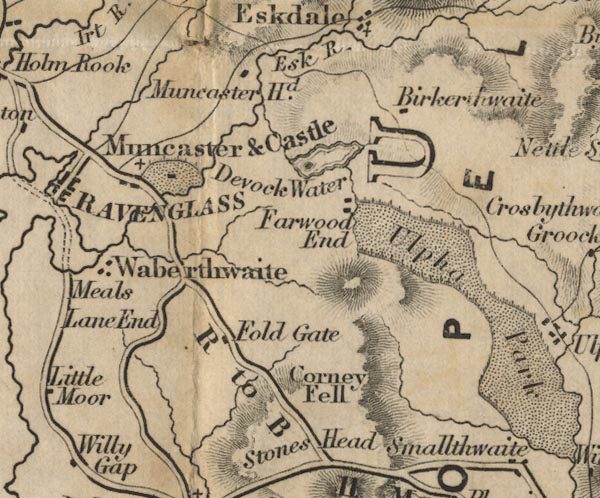
FD02SD19.jpg
"Muncaster &Castle"
Building and park.
item:- JandMN : 100.1
Image © see bottom of page
placename:- Muncaster Castle
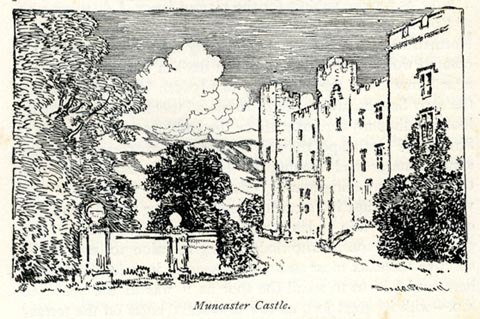 click to enlarge
click to enlargeBRL142.jpg
On page 182 of Highways and Byways in the Lake District, by A G Bradley.
printed at lower right:- "Joseph Pennell"
printed at lower left:- "AG"
printed at bottom:- "Muncaster Castle."
item:- JandMN : 464.42
Image © see bottom of page
 goto source
goto sourceGentleman's Magazine 1907 part 1 p.169 "..."
"Muncaster Castle and Hardknott"
"THERE is, perhaps, no more beautiful dwelling-place in this country than the Castle of Muncaster. It is a solid pile of red sandstone and granite buildings clustered round an old tower of Roman origin, called Agricola's Tower, the walls of which are nine feet, or thereabouts, in thickness. It stands high on the fellside on a kind of shoulder of the hill, gazing out over the valley of the Esk, out to sea to the west, away up to the mountain land, Sca Fell and his brethren, to the east."
"The origin of Muncaster fades away into the mists of tradition. The original Roman Tower was said to have been built to guard St. Michael's ford over the Esk, ..."
 goto source
goto sourceGentleman's Magazine 1907 part 1 p.170 "..."
"The family of Pennington (the family name of the Lords of Muncaster) came originally from Pennington in Lancashire, and most of the Penningtons served their country in some way or another. The first Pennington who emerged into history was Gamel de Pennington, he who first removed from Lancashire to Muncaster, or Moelcastre, as it was originally called."
"..."
"... Here [Walls Castle], probably, the Penningtons dwelt till some time in the Middle Ages, when they betook themselves to the Roman Tower, a mile further up the hill, which by this time had become metamorphosed into the usual "pele tower" style of residence adopted by the nobles and gentlemen of the Border country. Northumberland, Cumberland, Westmoreland, and North Lancashire have many fine examples of these fortified manor-houses and castellated residences, whose existence is due to the proximity of the lawless moss-troopers, who pillaged the border counties. None of them, however, can compare with Muncaster for beauty of situation."
"..."
item:- Luck of Muncaster
 goto source
goto sourceGentleman's Magazine 1907 part 1 p.171 "... It is said that King Henry VI., when he fled from his enemies in 1461, was refused asylum at Irton Hall, and was found by a shepherd wandering on the fell at the spot where Chapels now stands. The shepherd brought him in"
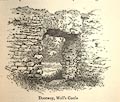 click to enlarge
click to enlargeG907E01.jpg
"safety to Muncaster, whose master, Sir John Pennington, took him in and concealed him. "Henry VI.'s room" is still at the Castle, and there is also a portrait of him painted on a wooden panel, in which he is represented as holding the glass goblet known as the "Luck of Muncaster" in his hand."
"The Luck of Muncaster is still in existence. It is a curiously-shaped vessel of greenish glass, studded with gold and white spots. It has no stem, being more of a bowl than anything else, and is about six inches in diameter by two and a half in height. It has been used at baptisms"
 goto source
goto sourceGentleman's Magazine 1907 part 1 p.172 "of members of the noble family to which it was given as a token of the gratitude of the fugitive King Henry."
"The first of the Penningtons to be elevated to the peerage was Sir John, fifth baronet, who was created Baron Muncaster in 1783. It is said that when he entered into possession of Muncaster Castle on his elevation to the peerage, he found it still surrounded by a moat and defended by a portcullis. The house was in such a ruinous condition that he was obliged to rebuild it almost entirely, with the exception of the pele tower."
"..."
placename:- Muncaster Castle
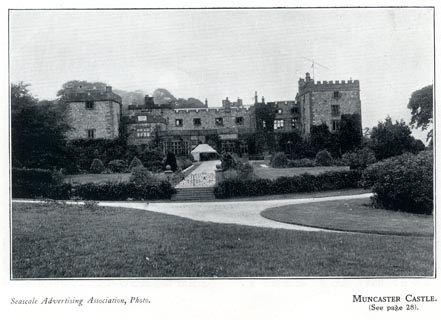 click to enlarge
click to enlargeSES111.jpg
item:- JandMN : 1079.11
Image © see bottom of page
placename:- Muncaster Castle
courtesy of English Heritage
"MUNCASTER CASTLE / / A595 / MUNCASTER / COPELAND / CUMBRIA / I / 76270 / SD1035596332"
courtesy of English Heritage
"Large house incorporating (C13?) fortified tower in the south-west corner; remodelled and enlarged 1862-66 by Anthony Salvin for the 4th Lord Muncaster. Coursed rubble with quoins and sandstone detailing; embattled parapets, some carried on cavetto eaves. Graduated slate roofs; corniced stone chimneys. U-shaped plan with tower at end of each arm; mainly 2 and 3 storeys. Main entrance on south side in full-height porch. Scattered fenestration, mainly C19, of multi-light stone-mullioned (and transomed) windows. Very fine interior includes panelled Hall, drawing room (with decorative plasterwork to segmental ceiling), and octagonal library with galleries. For detailed description, see Pevsner, BUILDINGS OF ENGLAND : CUMBERLAND AND WESTMORLAND pp165 and 166 (1980 edition)."
courtesy of English Heritage
"MONUMENT NORTH EAST OF MUNCASTER CASTLE / / A595 / MUNCASTER / COPELAND / CUMBRIA / II / 76267 / SD1107897490"
courtesy of English Heritage
"Eyecatcher, probably mid C18. Rough-dressed granite boulders with quoins; battered, with banding between floors. Pyramidal roof of stone blocks. 3 stages, octagonal in plan c65 ft high. Intended to appear medieval when viewed from a distance but lacks fine detailing. Entrance has pointed head and splayed jambs. Oculi to each side between the lower stages light the ground floor. 1st floor probably entered externally through opening on north-west face; blind Latin crosses to remaining faces. 2nd floor has small window, in rusticated surround, to each face. Interior: Spiral, domical vaults to ground and 1st floors; niches of varying size to ground-floor walls. Said to mark the place where shepherds found Henry VI wandering the Fells after the battle of Towton in 1461."
courtesy of English Heritage
"ENTRANCE GATEWAY AND WALLS TO NORTH OF MUNCASTER CASTLE / / A595 / MUNCASTER / COPELAND / CUMBRIA / II / 76271 / SD0978696642"
courtesy of English Heritage
"Entrance gateway and walls; 2 builds, probably late C18/early C19. Ashlar gateway has parapet; rough-dressed quoins and surrounds. Splayed walls of random rubble with chamfered copings. Gateway has taller central section with coat-of-arms and Pennington badges above semicircular-headed carriage arch; wrought-iron gates with scrollwork panels. Piers, square in plan with caps, to inner ends of walls."
placename:- Muncaster Castle
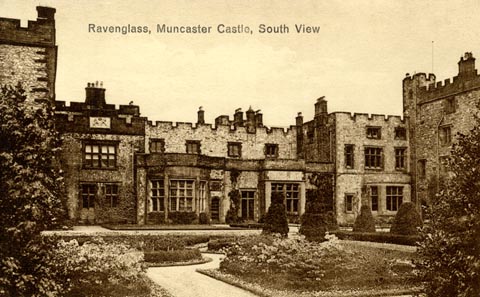 click to enlarge
click to enlargePH0076.jpg
printed at top:- "Ravenglass, Muncaster Castle, South View"
item:- JandMN : 944
Image © see bottom of page
placename:- Muncaster Castle
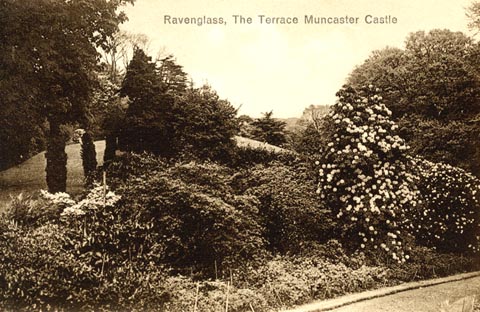 click to enlarge
click to enlargePH0077.jpg
printed at top:- "Ravenglass, The Terrace Muncaster Castle"
item:- JandMN : 945
Image © see bottom of page
placename:- Muncaster Castle
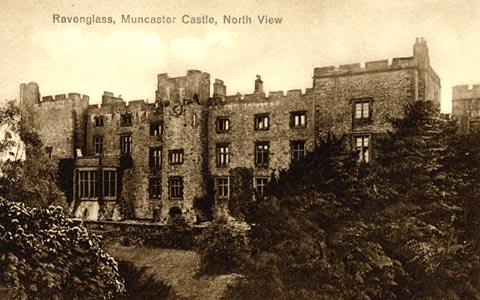 click to enlarge
click to enlargePH0078.jpg
printed at top:- "Ravenglass, Muncaster Castle, North View"
item:- JandMN : 946
Image © see bottom of page
placename:- Muncaster Castle
 click to enlarge
click to enlargePR0103.jpg
printed at bottom centre:- "MUNCASTER CASTLE."
item:- Dove Cottage : 2008.107.103
Image © see bottom of page
placename:- Muncaster Castle
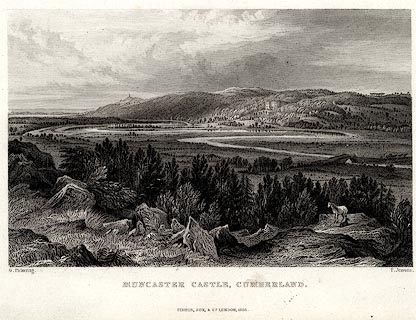 click to enlarge
click to enlargePR0040.jpg
vol.3 pl.26 in the set of prints, Westmorland, Cumberland, Durham and Northumberland Illustrated.
printed at bottom left, right, centre:- "G. Pickering. / T. Jeavons. / MUNCASTER CASTLE, CUMBERLAND. / FISHER, SON &CO. LONDON, 1835."
item:- Dove Cottage : 2008.107.40
Image © see bottom of page
placename:- Muncaster Castle
item:- Luck of Muncaster
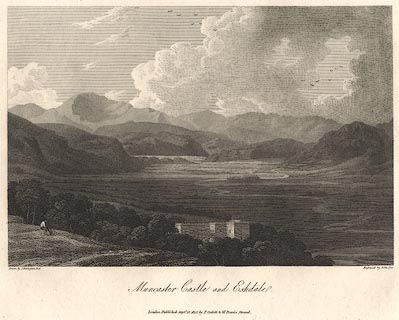 click to enlarge
click to enlargeBNV38.jpg
Plate 26 in The Lakes of Lancashire, Westmorland and Cumberland ... with text by Thomas Hartwell Horne:- "VIEW OF MUNCASTER CASTLE. / THE Manor of Muncaster is known to have belonged to the Pennington family as early as the reign of Henry II. Sir John Pennington, who lived in the reign of Henry VI., is said to have secreted that unhappy monarch in his flight from his enemies; and the tradition of the family is, that on quitting Muncaster he presented his host with a small glass vessel, still preserved in the family, and called the Luck of Muncaster, to the preservation of which a considerable degree of superstition is attached. This Sir John Pennington is said to have been a distinguished military character, and to have commanded the left wing of the English army in an expedition against Scotland. His grandson, of the same name, was in the battle of Flodden Field. Another descendant, of the same name, was Admiral to King Charles I. and much trusted by that monarch in naval affairs. Sir William Pennington, grandson of the last-mentioned Sir John, was created a Baronet in 1676. Sir John Pennington, the fifth Baronet, was, in 1783, created Lord Muncaster, of the Kingdom of Ireland; he died in 1813, leaving only one surviving daughter, married to Lord Lindsay, son of the Earl of Balcarras, when the title of Muncaster and the Muncaster estates, being settled on male heirs, devolved to his brother, General Lowther Pennington, now Lord Muncaster. / Muncaster cstle, which retains the principal tower of the ancient fortifiied mansion, though it has lost its original form, was nearly rebuilt by the late Lord Muncaster. It stands on an eminence, nearly surrounded by beautiful plantations, and commanding in front a fine view of the Vale of Esk, flanked on each side, and terminated in front, by the wildest mountain scenery. In the house are several family pictures, and a curious portrait of Thomas Skelton, the fool of Muncaster, who is said to have lived in the family at the time of the civil wars, and of whose sayings there are many traditional stories. ..."
item:- private collection : 75
Image © see bottom of page
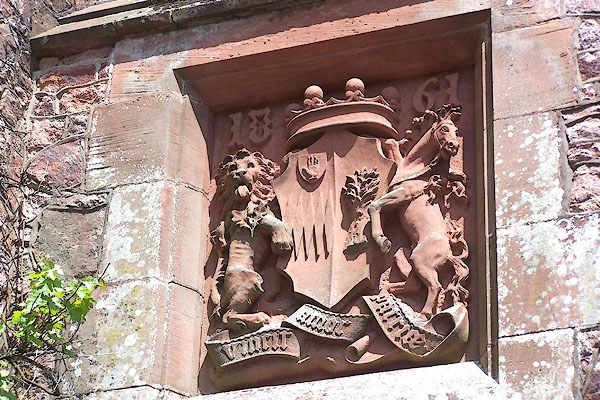
BNT93.jpg Coat of arms, Pennington Family, 1861.
(taken 5.6.2007)
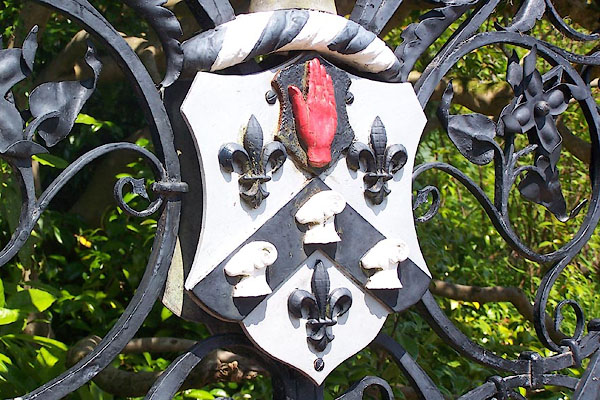
BNT94.jpg (taken 5.6.2007)
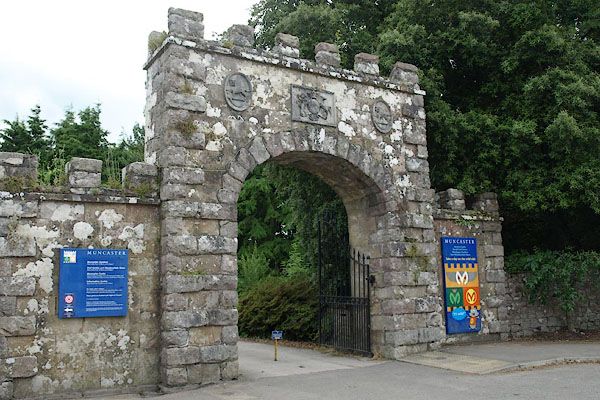
BTE42.jpg Main gate.
(taken 13.7.2010)
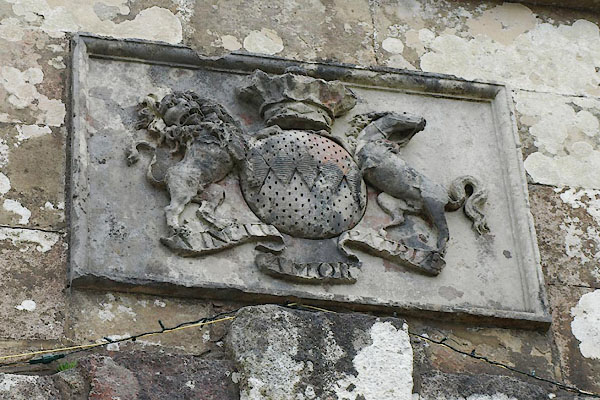
BTE43.jpg Coat of arms on main gate.
(taken 13.7.2010)
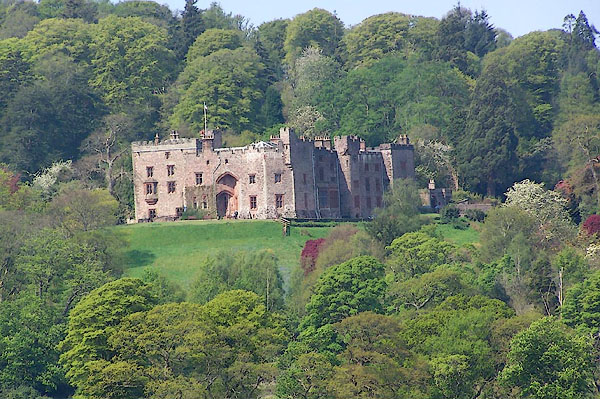
BMB35.jpg (taken 11.5.2006)
